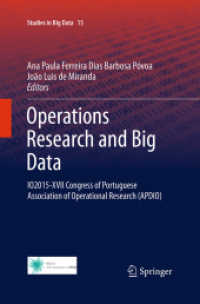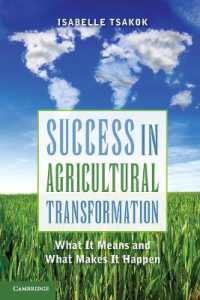Full Description
Introducing Translation Studies has long been the definitive guide to the theories and concepts that make up the field of translation studies. Providing an accessible and up-to-date overview, it is the essential textbook, used on courses worldwide.
This sixth edition has been substantially revised throughout to include important new material and it continues to provide a balanced and detailed guide to the theoretical landscape. The theories are applied to a wide range of languages, including Arabic, Bengali, Chinese, English, Punjabi, Portuguese, French and German. A broad spectrum of texts are analysed, including websites, European Union documents, travel brochures, children's books, Buddhist sutras, literary texts and films. Each chapter comprises an introduction outlining the theories, illustrative texts with translations, case studies, a chapter summary, and discussion points and exercises.
New features in this sixth edition include:
● Updated content reflecting current research and practice: every chapter of this new edition incorporates recent developments, notably in multimodal communication, cognitive approaches to translation, translation and gender, the ideology of translation, and hermeneutics. It also offers a more globally balanced representation of theoretical perspectives and includes a newly structured discussion on translation in the digital age, including the impact of machine translation and AI-powered large language models
● Revised discussion points and refreshed data: figures and tables have been updated throughout to reflect the most recent information
● New in-chapter activities, with integrated links from the interactive ebook to online resources and articles, encouraging independent research and deeper engagement
● Extensive updated online resources: features include quizzes, flashcards, specially recorded new video introductions, curated journal articles for each chapter, helpful weblinks, and downloadable PowerPoint slides to support instructors.
This new edition ensures Introducing Translation Studies remains the ideal textbook for students and researchers engaged in courses in translation and translation studies worldwide.
Contents
Ackowledgements
List of abbreviations
List of figures and tables
Introduction
Chapter 1
Main issues of translation studies
1.0 Introduction
1.1 The concept of translation
1.2 What is translation studies?
1.3 An early history of the discipline
1.4 The Holmes/Toury 'map'
1.5 Developments since Holmes
1.6 The van Doorslaer 'map'
1.7 Audiovisual translation
1.8 Discipline, interdiscipline or multidiscipline?
Chapter 2
The basic concepts of early translation theory
2.0 Introduction
2.1 'Word-for-word' or 'sense-for-sense'?
2.2 Early Chinese and Arabic discourse on translation
2.3 European Humanism and the Protestant Reformation
2.4 Fidelity, spirit and truth
2.5 Early attempts at systematic translation theory: Dryden, Dolet, Tytler and Yán Fù
2.6 Schleiermacher and the valorization of the foreign
2.7 Towards contemporary translation theory
Chapter 3
Equivalence and meaning
3.0 Introduction
3.1 Roman Jakobson: the nature of linguistic meaning and equivalence
3.2 Nida and 'the science of translating'
3.3 Koller: equivalence relations
3.4 Later developments in equivalence
Chapter 4
Studying translation product and process
4.0 Introduction
4.1 Vinay and Darbelnet's model
4.2 Catford and translation 'shifts'
4.3 Further influence and other proposed models
4.4 Option, markedness and stylistic shifts in translation
4.5 Corpus translation studies
4.6 The cognitive process of translation
Chapter 5
Functional theories of translation
5.0 Introduction
5.1 Text type and genre
5.2 Translatorial action
5.3 Skopos theory
5.4 Translation-oriented text analysis
Chapter 6
Discourse and Register analysis approaches
6.0 Introduction
6.1 The Hallidayan model of language and discourse
6.2 House's model of translation quality assessment
6.3 Baker's text and pragmatic level analysis
6.4 Hatim and Mason: the levels of context and discourse
6.5 The appraisal framework
6.6 Criticisms of discourse and Register analysis approaches to translation
6.7 Socio-narrative theory
Chapter 7
Systems theories
7.0 Introduction
7.1 Polysystem theory
7.2 Toury and descriptive translation studies
7.3 Chesterman's translation norms
7.4 Other models of descriptive translation studies: Lambert and van Gorp and the Manipulation School
Chapter 8
Cultural and ideological turns
8.0 Introduction
8.1 Translation as rewriting
8.2 Translation, gender studies and feminist studies
8.3 Queer translation
8.4 Transgender/trans* translation
8.5 Postcolonial translation theory
8.6 The ideologies of the theorists
8.7 Translation, ideology and power in other contexts
Chapter 9
The role of the translator: visibility, ethics and sociology
9.0 Introduction
9.1 The cultural and political agenda of translation
9.2 The position and positionality of the translator
9.3 The sociology and historiography of translation
9.4 The power network of the translation industry
9.5 Paratexts in translation
Chapter 10
Philosophical approaches to translation
10.0 Introduction
10.1 Steiner's hermeneutic motion
10.2 The task of the translator vs. the translator's task: Walter Benjamin
10.3 Deconstruction
10.4 Cannibalist theory of translation
Chapter 11
New directions and challenges
11.0 Introduction
11.1 New debates on the limits of translation
11.2 From target audience to participatory communities
11.3 Translation in the digital age of globalization
11.4 Eco-translation, labour issues and sustainability
Chapter 12
Research and commentary projects
12.0 Introduction
12.1 Towards a reconceptualization of translation studies
12.2 Translation commentaries
12.3 Research projects in translation studies
Bibliography
Index







